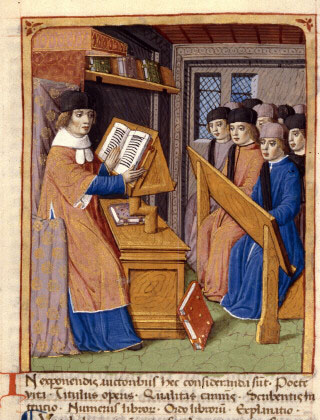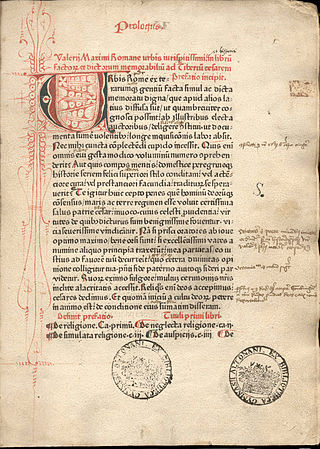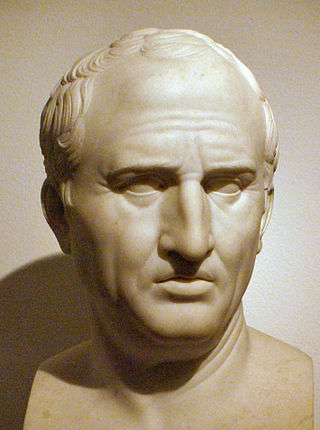Pompeius Grammaticus, also known as Pompeius the Grammarian, was a Latin grammarian of the fifth century, author of a Commentary on Donatus's grammar (Commentum artis Donati).
Not much is known of Pompeius' life. He taught in Africa at the end of the fifth or at the very beginning of the sixth century. [1]
Pompeius is known for his commentary on Donatus, centered on the Ars maior. This commentary was intended for school education, as shown by the care taken in explaining even the most basic points. [2]
A commentary on Virgil and a commentary on Terence were sometimes attributed to him, but these are mere hypotheses. [3]

Servius, distinguished as Servius the Grammarian, was a late fourth-century and early fifth-century grammarian. He earned a contemporary reputation as the most learned man of his generation in Italy; he authored a set of commentaries on the works of Virgil. These works, In Tria Virgilii Opera Expositio, Commentarii in Virgilium, Commentarii in Vergilii Opera, or Vergilii Carmina Commentarii, constituted the first incunable to be printed at Florence, by Bernardo Cennini, in 1471.

Valerius Maximus was a 1st-century Latin writer and author of a collection of historical anecdotes: Factorum et dictorum memorabilium libri IX. He worked during the reign of Tiberius.

Late Latin is the scholarly name for the form of Literary Latin of late antiquity. English dictionary definitions of Late Latin date this period from the 3rd to the 6th centuries CE, and continuing into the 7th century in the Iberian Peninsula. This somewhat ambiguously defined version of Latin was used between the eras of Classical Latin and Medieval Latin. Scholars do not agree exactly when Classical Latin should end or Medieval Latin should begin.

Sextus Pompeius Festus, usually known simply as Festus, was a Roman grammarian who probably flourished in the later 2nd century AD, perhaps at Narbo (Narbonne) in Gaul.
The gens Scribonia was a plebeian family of ancient Rome. Members of this gens first appear in history at the time of the Second Punic War, but the first of the Scribonii to obtain the consulship was Gaius Scribonius Curio in 76 BC.
Virgilius Maro Grammaticus, known in English as Virgil the Grammarian or Virgil of Toulouse, is the author of two early medieval grammatical texts known as the Epitomae and the Epistolae.

Tatwine was the tenth Archbishop of Canterbury from 731 to 734. Prior to becoming archbishop, he was a monk and abbot of a Benedictine monastery. Besides his ecclesiastical career, Tatwine was a writer, and riddles he composed survive. Another work he composed was on the grammar of the Latin language, which was aimed at advanced students of that language. He was subsequently considered a saint.
Nora Elisabeth Mary Boyce was a British scholar of Iranian languages, and an authority on Zoroastrianism. She was Professor of Iranian Studies at the School of Oriental and African Studies (SOAS) of the University of London. The Royal Asiatic Society's annual Boyce Prize for outstanding contributions to the study of religion is named after her.
Diomedes Grammaticus was a Latin grammarian who probably lived in the late 4th century AD. He wrote a grammatical treatise, known either as De Oratione et Partibus Orationis et Vario Genere Metrorum libri III or Ars grammatica in three books, dedicated to a certain Athanasius. Since he is frequently quoted by Priscian, he must have lived before the year 500. His third book on poetry is particularly valuable, containing extracts from Suetonius's De poetica. This book contains one of the most complete lists of types of dactylic hexameters in antiquity, including the teres versus, which may be the so-called "golden line." Diomedes wrote about the same time as Charisius and used the same sources independently. The works of both grammarians are valuable, but whereas much of Charisius has been lost, the Ars of Diomedes has come down to us complete. In book I he discusses the eight parts of speech; in II the elementary ideas of grammar and of style; in III poetry, quantity, and meters. The best edition is in H. Keil's Grammatici Latini, vol I.
Remigius (Remi) of Auxerre was a Benedictine monk during the Carolingian period, a teacher of Latin grammar, and a prolific author of commentaries on classical Greek and Latin texts. He is also accredited with collecting and compiling other early medieval thinkers' commentaries on these works.

Education in ancient Rome progressed from an informal, familial system of education in the early Republic to a tuition-based system during the late Republic and the Empire. The Roman education system was based on the Greek system – and many of the private tutors in the Roman system were enslaved Greeks or freedmen. The educational methodology and curriculum used in Rome was copied in its provinces and provided a basis for education systems throughout later Western civilization. Organized education remained relatively rare, and there are few primary sources or accounts of the Roman educational process until the 2nd century AD. Due to the extensive power wielded by the pater familias over Roman families, the level and quality of education provided to Roman children varied drastically from family to family; nevertheless, Roman popular morality came eventually to expect fathers to have their children educated to some extent, and a complete advanced education was expected of any Roman who wished to enter politics.
Peter of Pisa, also known as Petrus Grammaticus, was an Italian grammarian, deacon and poet in the Early Middle Ages. In 776, after Charlemagne's conquest of the Lombard Kingdom, Peter was summoned to the Carolingian court along with Paul the Deacon and Alcuin. Peter had originally taught at Pavia, in Italy. Peter of Pisa was asked to be Charlemagne’s primary Latin teacher. Peter’s poetry provides a personal look at the workings of the innermost sanctum surrounding Charlemagne. Peter’s grammar texts provide insight into the transformation Latin education underwent in this period.

The writings of Marcus Tullius Cicero constitute one of the most renowned collections of historical and philosophical work in all of classical antiquity. Cicero was a Roman politician, lawyer, orator, political theorist, philosopher, and constitutionalist who lived during the years of 106–43 BC. He held the positions of Roman senator and Roman consul (chief-magistrate) and played a critical role in the transformation of the Roman Republic into the Roman Empire. He was extant during the rule of prominent Roman politicians, such as those of Julius Caesar, Pompey, and Marc Antony. Cicero is widely considered one of Rome's greatest orators and prose stylists.
Junius Philargyrius was an early commentator on the Bucolica and Georgica of Vergil, dedicated to a certain Valentinianus. He was a member of the Junia gens, active in Milan.
Titus Gallus is an early Vergilian commentator, fl. in the 5th or 6th century. He is known only from a mention in the Berne scholia, haec omnia de commentariis Romanorum congregavi, id est Titi Galli et Gaudentii et maxime Iunilii Flagrii Mediolanensis.
The Lexicon Iconographicum Mythologiae Classicae is a multivolume encyclopedia cataloguing representations of mythology in the plastic arts of classical antiquity. Published serially from 1981 to 2009, it is the most extensive resource of its kind, providing "full and detailed information." Entries are arranged alphabetically, with black-and-white illustrations indexed to their respective entries.

De verborum significatione libri XX, also known as the Lexicon of Festus, is an epitome compiled, edited, and annotated by Sextus Pompeius Festus from the encyclopedic works of Verrius Flaccus. Festus' epitome is typically dated to the 2nd century, but the work only survives in an incomplete 11th-century manuscript and copies of its own separate epitome.
Atilius Fortunatianus was a Latin grammarian. He was the author of a treatise on metres, dedicated to one of his pupils, a youth of senatorial rank, who desired to be instructed in the Horatian metres. The manual opens with a discussion of the fundamental ideas of metre and the chief rules of prosody, and ends with a detailed analysis of the metres of Horace. The chief authorities used are Caesius Bassus and the Latin adaptation by Juba the grammarian of the Τέχνη of Heliodorus. Fortunatianus being a common name in the African provinces, it is probable that the author was a countryman of Juba, Terentianus Maurus and Victorinus.

Iomnium was a Phoenician, Carthaginian, and Roman port on Algeria's Mediterranean coast at the site of present-day Tigzirt.
Marius Plotius Sacerdos was a Roman grammarian who flourished towards the end of the third century CE. He wrote an ars grammatica in three books, the third of which treats of meter.